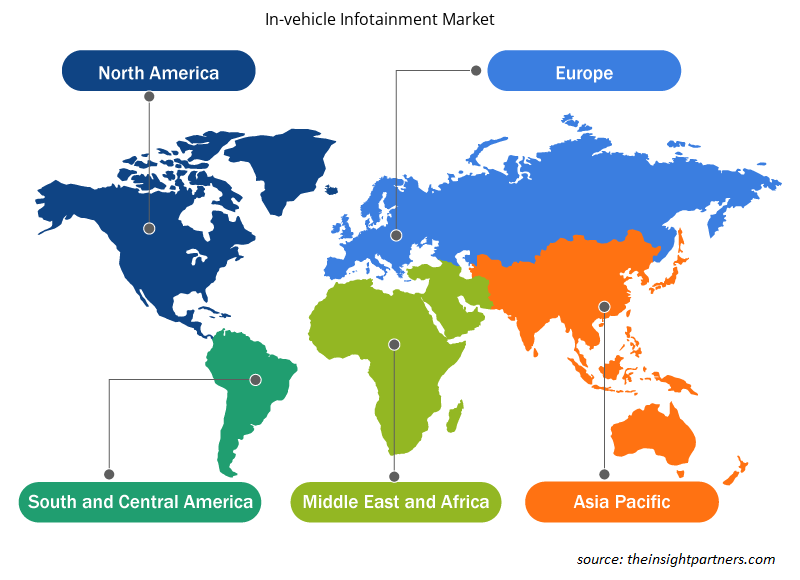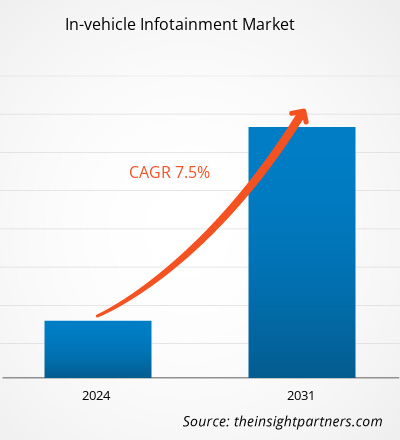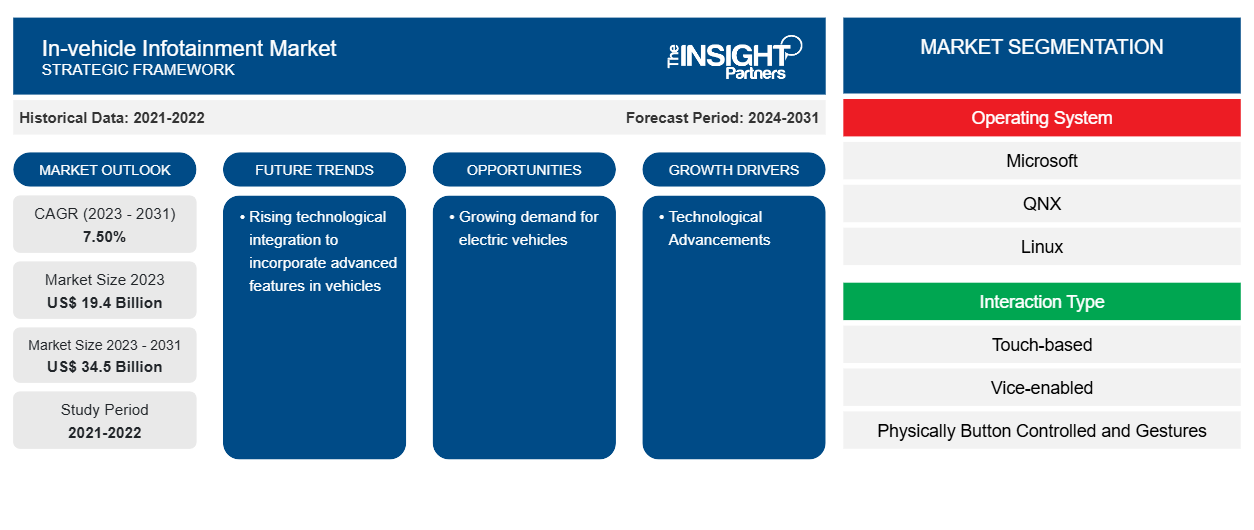La taille du marché de l'infodivertissement embarqué devrait atteindre 34,5 milliards USD d'ici 2031, contre 19,4 milliards USD en 2023. Le marché devrait enregistrer un TCAC de 7,50 % en 2023-2031. L'intégration du système avancé d'assistance à la conduite (ADAS) dans le système d'infodivertissement est l'une des tendances récentes du secteur. Les fonctionnalités ADAS telles que les avertissements de sortie de voie, l'assistance au stationnement et le régulateur de vitesse adaptatif sont quelques-unes des tendances récentes du secteur qui génèrent des opportunités lucratives.CAGR of 7.50% in 2023–2031. Integration of Advanced Drivers Assistance System (ADAS) in the infotainment system is one of the recent trends in the industry. ADAS features such as Lane departure warnings, parking assistance, adaptive cruise control are some of the recent trends in the industry that are generating lucrative opportunities.
Analyse du marché de l'infodivertissement embarqué
L'augmentation de la production et des ventes de véhicules de tourisme est l'un des facteurs notables qui stimulent la croissance du marché des systèmes d'infodivertissement embarqués. À l'échelle mondiale, en raison de l'urbanisation accrue et de l'augmentation du revenu disponible, les ventes de véhicules de tourisme ont augmenté au cours des dernières années. Selon les données publiées par l'Organisation internationale des constructeurs d'automobiles en 2023, la production mondiale de voitures particulières a atteint 58 millions d'unités en 2022, mais en 2023, la production en 2023 a atteint 65 millions d'unités. Cette augmentation de la production et des ventes de véhicules par an stimule la demande du marché de l'infodivertissement embarqué.
Aperçu du marché de l'infodivertissement embarqué
La demande de systèmes d'infodivertissement embarqués dans la région Asie-Pacifique, tout comme la demande de véhicules de tourisme, a augmenté au cours des dernières années. La demande est principalement motivée par l'augmentation du revenu disponible dans la région Asie-Pacifique. Selon les données fournies par l'Organisation internationale des constructeurs d'automobiles en 2023, la production de voitures particulières dans la région était de 18 millions en 2021, cependant, la production de voitures particulières a atteint 24 millions en 2022. Une telle augmentation du volume des ventes de véhicules a entraîné une augmentation de la demande du marché de l'infodivertissement embarqué dans la région Asie-Pacifique.
Personnalisez ce rapport en fonction de vos besoins
Vous bénéficierez d'une personnalisation gratuite de n'importe quel rapport, y compris de certaines parties de ce rapport, d'une analyse au niveau des pays, d'un pack de données Excel, ainsi que d'offres et de remises exceptionnelles pour les start-ups et les universités.
-
Obtenez les principales tendances clés du marché de ce rapport.Cet échantillon GRATUIT comprendra une analyse de données, allant des tendances du marché aux estimations et prévisions.
Facteurs moteurs et opportunités du marché de l'infodivertissement embarqué
Progrès technologiques
L’un des facteurs notables à l’origine de la croissance du marché est l’avancée technologique dans le domaine des smartphones et de la technologie cloud. À mesure que la pénétration des smartphones s’est accrue, de nombreux fabricants de systèmes d’infodivertissement pour véhicules ont commencé à proposer des systèmes dotés d’ une connectivité pour smartphone . De plus, à mesure que le concept de la technologie cloud a émergé dans les logiciels d’infodivertissement pour véhicules, les sociétés ont commencé à utiliser la technologie cloud pour fournir des fonctionnalités et des services personnalisés. Ainsi, en raison de l’évolution technologique de l’infodivertissement embarqué, la demande d’infodivertissement embarqué a augmenté à l’échelle mondiale.
Intégration de l'intelligence artificielle
La demande de véhicules autonomes augmente rapidement et les systèmes d’infodivertissement embarqués évoluent en même temps. De plus, le nombre d’écrans dans les voitures particulières augmente également, car la demande de divertissement et d’autonomie augmente. Ainsi, de nombreux acteurs de l’industrie automobile se concentrent sur l’intégration de l’intelligence artificielle dans leurs voitures en tant qu’assistant du conducteur.
Analyse de segmentation du rapport sur le marché de l'infodivertissement embarqué
Les segments clés qui ont contribué à l’élaboration de l’analyse du marché de l’infodivertissement embarqué sont le système d’exploitation, le type d’interaction et la technologie de connectivité.
- En fonction du système d’exploitation, le marché de l’infodivertissement embarqué est divisé en Microsoft, QNX, Linux.QNX, Linux.
- En fonction du type d'interaction, le marché est segmenté en interface tactile, interface utilisateur, interface utilisateur à boutons physiques et interface gestuelle. Le segment tactile détenait la plus grande part du marché en 2023.
- En termes de catégorie, le marché est divisé en Wi-Fi, Bluetooth et NFC. Le segment Bluetooth a dominé le marché en 2023.
Analyse des parts de marché de l'infodivertissement embarqué par zone géographique
La portée géographique du rapport sur le marché de l’infodivertissement embarqué est principalement divisée en cinq régions : Amérique du Nord, Asie-Pacifique, Europe, Moyen-Orient et Afrique, et Amérique du Sud/Amérique du Sud et centrale.
Le marché mondial de l'infodivertissement embarqué est dominé par la région Asie-Pacifique ; cependant, l'Amérique du Nord et l'Europe sont également l'une des régions notables de l'industrie. Dans la région Asie-Pacifique, la Chine est devenue le centre de fabrication de l'industrie automobile mondiale. Selon les données disponibles dans le domaine public, les ventes automobiles de la Chine ont connu une croissance de 12 % en 2023 par rapport à 2022. En outre, selon les statistiques récentes, la Chine a déclaré des exportations de plus de 5 millions en 2023. Une industrie automobile aussi forte dans la région Asie-Pacifique a entraîné une augmentation de la demande de systèmes d'infodivertissement embarqués.
Aperçu régional du marché de l'infodivertissement embarqué
Les tendances et facteurs régionaux influençant le marché de l’infodivertissement embarqué tout au long de la période de prévision ont été expliqués en détail par les analystes d’Insight Partners. Cette section traite également des segments et de la géographie du marché de l’infodivertissement embarqué en Amérique du Nord, en Europe, en Asie-Pacifique, au Moyen-Orient et en Afrique, ainsi qu’en Amérique du Sud et en Amérique centrale.

- Obtenez les données régionales spécifiques au marché de l'infodivertissement embarqué
Portée du rapport sur le marché de l'infodivertissement embarqué
| Attribut de rapport | Détails |
|---|---|
| Taille du marché en 2023 | 19,4 milliards de dollars américains |
| Taille du marché d'ici 2031 | 34,5 milliards de dollars américains |
| Taux de croissance annuel composé mondial (2023-2031) | 7,50% |
| Données historiques | 2021-2022 |
| Période de prévision | 2024-2031 |
| Segments couverts |
Par système d'exploitation
|
| Régions et pays couverts |
Amérique du Nord
|
| Leaders du marché et profils d'entreprises clés |
|
Densité des acteurs du marché : comprendre son impact sur la dynamique des entreprises
Le marché de l'infodivertissement embarqué connaît une croissance rapide, tirée par la demande croissante des utilisateurs finaux en raison de facteurs tels que l'évolution des préférences des consommateurs, les avancées technologiques et une plus grande sensibilisation aux avantages du produit. À mesure que la demande augmente, les entreprises élargissent leurs offres, innovent pour répondre aux besoins des consommateurs et capitalisent sur les tendances émergentes, ce qui alimente davantage la croissance du marché.
La densité des acteurs du marché fait référence à la répartition des entreprises ou des sociétés opérant sur un marché ou un secteur particulier. Elle indique le nombre de concurrents (acteurs du marché) présents sur un marché donné par rapport à sa taille ou à sa valeur marchande totale.
Les principales entreprises opérant sur le marché de l'infodivertissement embarqué sont :
- Alpine Électronique, Inc.
- Clarion Co., Ltd.
- Continental AG
- Denso Ten Limitée
- Garmin Ltd.
- Harman International
Avis de non-responsabilité : les sociétés répertoriées ci-dessus ne sont pas classées dans un ordre particulier.

- Obtenez un aperçu des principaux acteurs du marché de l'infodivertissement embarqué
Actualités et développements récents du marché de l'infodivertissement embarqué
Le marché de l'infodivertissement embarqué est évalué en collectant des données qualitatives et quantitatives après des recherches primaires et secondaires, qui comprennent des publications d'entreprise importantes, des données d'association et des bases de données. Voici une liste des développements sur le marché de l'infodivertissement embarqué et des stratégies :
- Snapp Automotive a lancé un système d'infodivertissement automobile Android. SnappOS est un système d'infodivertissement personnalisable, contextuel et intelligent permettant des cycles de développement et de déploiement rapides dans des environnements réels ou simulés. (Source : Snapp Automotive, communiqué de presse/site Web de l'entreprise/bulletin d'information, 2022)
- Panasonic Automotive System a annoncé une mise à jour de son système d'infodivertissement embarqué (IVI) SkipGen qui donne accès à Siri ou Alexa. (Source : Panasonic Automotive System, Communiqué de presse/Site Web de l'entreprise/Bulletin d'information, 2023)
Rapport sur le marché de l'infodivertissement embarqué : couverture et livrables
Le rapport « Taille et prévisions du marché de l’infodivertissement embarqué (2021-2031) » fournit une analyse détaillée du marché couvrant les domaines ci-dessous :
- Taille du marché et prévisions aux niveaux mondial, régional et national pour tous les segments de marché clés couverts par le périmètre
- Dynamique du marché, comme les facteurs moteurs, les contraintes et les opportunités clés
- Principales tendances futures
- Analyse détaillée des cinq forces de PEST/Porter et SWOT
- Analyse du marché mondial et régional couvrant les principales tendances du marché, les principaux acteurs, les réglementations et les développements récents du marché
- Analyse du paysage industriel et de la concurrence couvrant la concentration du marché, l'analyse de la carte thermique, les principaux acteurs et les développements récents
- Profils d'entreprise détaillés
- Analyse historique (2 ans), année de base, prévision (7 ans) avec TCAC
- Analyse PEST et SWOT
- Taille du marché Valeur / Volume - Mondial, Régional, Pays
- Industrie et paysage concurrentiel
- Ensemble de données Excel
Rapports récents
Rapports connexes
Témoignages
Raison d'acheter
- Prise de décision éclairée
- Compréhension de la dynamique du marché
- Analyse concurrentielle
- Connaissances clients
- Prévisions de marché
- Atténuation des risques
- Planification stratégique
- Justification des investissements
- Identification des marchés émergents
- Amélioration des stratégies marketing
- Amélioration de l'efficacité opérationnelle
- Alignement sur les tendances réglementaires























 Obtenez un échantillon gratuit pour - Marché de l'infodivertissement embarqué
Obtenez un échantillon gratuit pour - Marché de l'infodivertissement embarqué